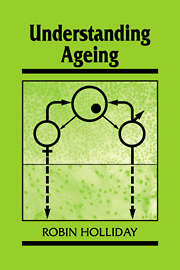Book contents
- Frontmatter
- Contents
- Preface
- Author's note
- Acknowledgements
- 1 Introduction
- 2 The evolved anatomical and physiological design of mammals
- 3 Maintenance of the adult organism
- 4 Theories of ageing
- 5 Cellular ageing
- 6 Genetic programmes for ageing
- 7 The evolution of longevity
- 8 Human disease and ageing
- 9 A better understanding of ageing
- Notes
- References
- Author index
- Subject index
4 - Theories of ageing
Published online by Cambridge University Press: 31 March 2010
- Frontmatter
- Contents
- Preface
- Author's note
- Acknowledgements
- 1 Introduction
- 2 The evolved anatomical and physiological design of mammals
- 3 Maintenance of the adult organism
- 4 Theories of ageing
- 5 Cellular ageing
- 6 Genetic programmes for ageing
- 7 The evolution of longevity
- 8 Human disease and ageing
- 9 A better understanding of ageing
- Notes
- References
- Author index
- Subject index
Summary
In Chapter 3 we saw that changes during ageing can occur in many components of the body, yet it is common to refer to the process of ageing, as if there was some underlying single mechanism that produced all these deleterious phenotypes. This is also often the case when a theory of ageing is proposed: in the formulation and presentation of the theory, the author often presupposes that there is one major mechanism or process that needs to be understood or explained. Thus, the significance of any particular theory is often overstated by its originator or supporter. The situation is made worse by the multiplicity of theories that have been discussed in this century. Many can now be ignored because they are outdated and have little relevance to modern knowledge. Medvedev (1990) has recently reviewed a large number of molecular and cellular theories, and has classified them into groups of related or overlapping proposals. It is probable that many of these have some basis of truth, and that none on its own ‘explains’ ageing. In this chapter some of the major proposals are reviewed, as are any pertinent experimental data that either confirm or are contrary to the theory's predictions. It is significant that the theories all relate in one way or another to the various maintenance mechanisms that were reviewed in the previous chapter.
- Type
- Chapter
- Information
- Understanding Ageing , pp. 41 - 66Publisher: Cambridge University PressPrint publication year: 1995
- 3
- Cited by



